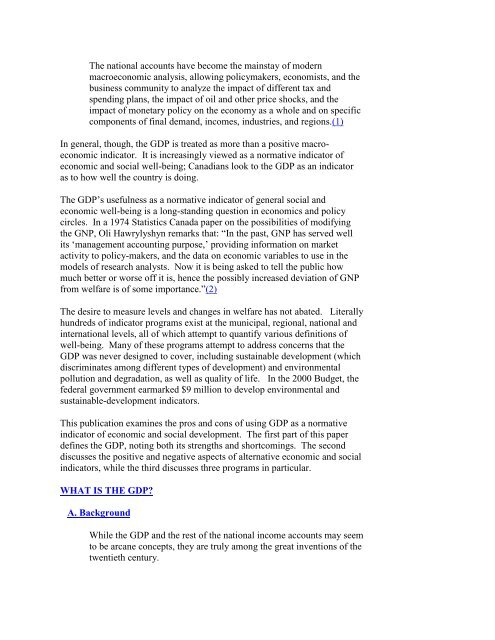THE GROSS DOMESTIC PRODUCT AND.pdf - Wikiprogress
THE GROSS DOMESTIC PRODUCT AND.pdf - Wikiprogress
THE GROSS DOMESTIC PRODUCT AND.pdf - Wikiprogress
You also want an ePaper? Increase the reach of your titles
YUMPU automatically turns print PDFs into web optimized ePapers that Google loves.
The national accounts have become the mainstay of modernmacroeconomic analysis, allowing policymakers, economists, and thebusiness community to analyze the impact of different tax andspending plans, the impact of oil and other price shocks, and theimpact of monetary policy on the economy as a whole and on specificcomponents of final demand, incomes, industries, and regions.(1)In general, though, the GDP is treated as more than a positive macroeconomicindicator. It is increasingly viewed as a normative indicator ofeconomic and social well-being; Canadians look to the GDP as an indicatoras to how well the country is doing.The GDP‟s usefulness as a normative indicator of general social andeconomic well-being is a long-standing question in economics and policycircles. In a 1974 Statistics Canada paper on the possibilities of modifyingthe GNP, Oli Hawrylyshyn remarks that: “In the past, GNP has served wellits „management accounting purpose,‟ providing information on marketactivity to policy-makers, and the data on economic variables to use in themodels of research analysts. Now it is being asked to tell the public howmuch better or worse off it is, hence the possibly increased deviation of GNPfrom welfare is of some importance.”(2)The desire to measure levels and changes in welfare has not abated. Literallyhundreds of indicator programs exist at the municipal, regional, national andinternational levels, all of which attempt to quantify various definitions ofwell-being. Many of these programs attempt to address concerns that theGDP was never designed to cover, including sustainable development (whichdiscriminates among different types of development) and environmentalpollution and degradation, as well as quality of life. In the 2000 Budget, thefederal government earmarked $9 million to develop environmental andsustainable-development indicators.This publication examines the pros and cons of using GDP as a normativeindicator of economic and social development. The first part of this paperdefines the GDP, noting both its strengths and shortcomings. The seconddiscusses the positive and negative aspects of alternative economic and socialindicators, while the third discusses three programs in particular.WHAT IS <strong>THE</strong> GDP?A. BackgroundWhile the GDP and the rest of the national income accounts may seemto be arcane concepts, they are truly among the great inventions of thetwentieth century.














